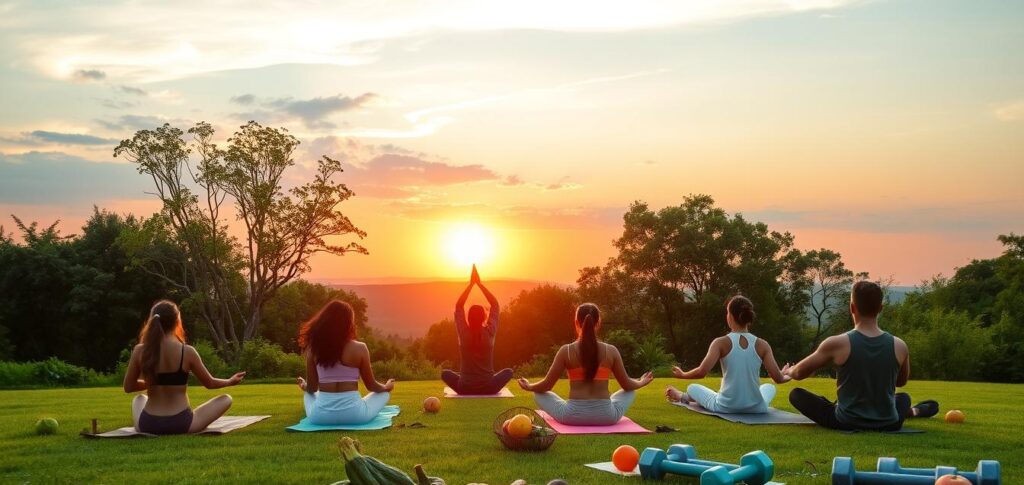Your Ultimate Guide to Reaching Your Health and Fitness Goals
We invite you to elevate your health and wellness journey with our expert-backed guide. It focuses on health and wellness and fitness goals. As we approach 2024, it’s the perfect time to set new health and fitness goals. By February, many people have abandoned their New Year’s resolutions, but with the right strategy, you can stay on track and achieve your objectives. Setting S.M.A.R.T goals is crucial for success in health and wellness. This means making sure your goals are specific, measurable, achievable, relevant, and time-bound. For instance, instead of saying “I want to lose weight,” try “I want to lose 10 pounds in the next three months by exercising four times a week and eating a balanced diet.” This approach will help you create a clear plan and track your progress in the realm of health and wellness and fitness goals. Our guide will walk you through the essential steps to create a wellness road map. This includes self-assessment, seeking professional advice, and leveraging technology to support your health journey. We’ll also discuss the importance of consistency over intensity, hydration, and rest and recovery in achieving your fitness goals. Key Takeaways Set S.M.A.R.T goals to achieve success in health and wellness Start with achievable fitness goals to build momentum Incorporate physical activities into your daily routine to increase activity levels Stay hydrated to maintain energy levels and support muscle function Rest and recovery are vital for muscle repair and overall well-being Track your progress and celebrate milestones to enhance motivation Adapt your fitness routine to your lifestyle and health conditions Understanding the Foundations of Health and Wellness We think making a Wellness Strategy is key for good health and wellness. Our team helps you grasp the basics of health and wellness. It’s important to see how the Mind-Body Connection affects our health. A good Wellness Strategy covers many areas of life. This includes exercise, what we eat, and managing stress. Knowing these parts helps us make a full plan for health and wellness. For example, regular exercise boosts blood flow, mood, energy, and immune strength. It’s also crucial to set achievable health goals. Focus on four main areas: nutrition, exercise, sleep, and stress control. Balancing these can boost our well-being and lower disease risk. The Mind-Body Connection The Mind-Body Connection is vital for our health. Studies show mental health affects physical health a lot. Understanding this lets us care for our mental health better, leading to a more complete health approach. Key Components of Wellness Wellness includes several important parts: Physical activity Nutrition Stress management Sleep Setting Realistic Health Goals Setting realistic health goals helps us plan and make progress. For more info or to reach out, call 248-277-6426 or email team@fitnesswithkhans.com. Creating Your Personalized Wellness Strategy A Personalized Wellness approach is key to reaching our health and fitness goals. We need to know our current fitness level, set achievable goals, and plan how to stay active, eat right, and manage stress. A good Fitness Plan fits our unique needs and goals, considering our lifestyle, likes, and health. To start, we should look at our diet, exercise, and health to find what needs work. We might aim to exercise for 30 minutes, five times a week, or aim for a healthy BMI in six months. A detailed plan helps us cover all health bases, from exercise to nutrition and stress. Some important parts of a Personalized Wellness plan include: Physical Health Assessment: Check our diet, exercise, and health Exercise Goal: Aim for 30 minutes of exercise, five days a week Mental Health Assessment: Think about stress and how to handle it Starting our Personalized Wellness plan is the first step to reaching our health and fitness goals. We invite you to visit our website and check out our resources to begin your Fitness Plan today. Dimension of Wellness Goal Strategy Physical Health Achieve a healthy BMI Exercise for 30 minutes, 5 days a week Mental Health Reduce stress levels Practice mindfulness or meditation for 15 minutes daily Nutrition Fundamentals for Optimal Health Learning about nutrition basics is key for good health. Check out our resources on nutrition to learn about meal planning and staying hydrated. A balanced diet gives your body what it needs to work right. It helps keep your energy up, supports growth, and fights off diseases. Meal planning is all about the right mix of nutrients. You should eat a variety of foods, like fruits, veggies, whole grains, lean proteins, and healthy fats. Knowing how to plan meals helps you make better choices for your diet and life. For instance, about 33% of American women take calcium supplements, even though most get enough from their food. Staying hydrated is also vital. Water and electrolytes help keep your body working right. Dehydration can cause headaches, fatigue, and more serious issues like joint pain and asthma. By focusing on nutrition and meal planning, you can keep your body hydrated and healthy. Key Principles of Nutrition Fundamentals Eat a variety of foods from all food groups Stay hydrated by drinking plenty of water Limit processed and sugary foods Consult with a healthcare professional or registered dietitian for personalized nutrition advice By following these tips, you can make a meal plan that fits your health goals. We suggest checking out our resources on nutrition and meal planning to learn more about staying healthy. Exercise and Physical Activity Guidelines Regular physical activity is key for good health. Yet, only about one in five adults and teens get enough exercise. We suggest checking out our exercise guidelines to help you create a fitness plan that fits you. The U.S. Department of Health and Human Services says adults should do at least 150 minutes of moderate aerobic activity each week. This can be brisk walking, water aerobics, or dancing. Vigorous activities like running, swimming laps, and tennis also offer great health benefits. Adding physical activity to your daily life can help prevent chronic diseases. It also improves sleep, thinking, mental health, bone
Your Ultimate Guide to Reaching Your Health and Fitness Goals Read More »




